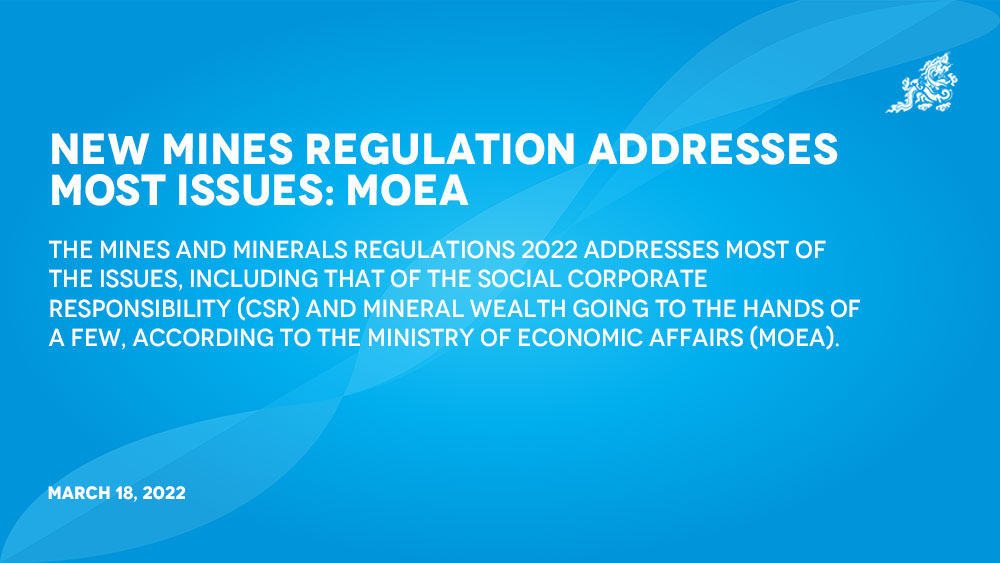MB Subba
The Mines and Minerals Regulations 2022 addresses most of the issues, including that of the social corporate responsibility (CSR) and mineral wealth going to the hands of a few, according to the Ministry of Economic Affairs (MoEA).
Affected communities often raise issues such as lack of benefits and compensation from mines and quarries.
The economic affairs minister, Loknath Sharma, said that there was no clarity on CSR in the old regulation and that only a few large companies implemented it. “The main change is on the CSR front, as it should be implemented by all mines and quarries now.”
One of the provisions under Chapter 11 of the new regulation mandates that the lessee to draw agreements with the local communities detailing community development projects and its implementation.
The regulation repeals the mines and minerals regulations 2002.
The new regulations, some officials say, takes a middle path approach to balance National Council’s (NC) concerns that mineral wealth was going to the hands of a few with the need to enable private sector growth.
The minister explained that only a few firms and individuals would be able to apply for large mines like the ones that have been leased to SMCL. With the adoption of the regulations, he said that profits from large mines would go to the state.
The government has added a new provision in the regulations, which makes private firms ineligible to operate mines that have been leased to a state-owned mining agency. As of today, coal, gypsum and dolomite have been leased to SMCL.
The regulation also prevents competition between the state-owned enterprise and private players.
The allocation of mineral to state-owned mining agency shall be based on wider economic benefits, high potential for export in primary form, potential for generating substantial revenue and sustainable development of mineral resources.
Lyonpo said that while the large and strategic mines have been leased to SMCL, the private players can apply for smaller mines. “Mining is one of the most important sectors in the economy.”
However, some of the issues that were pointed out in the past by various quarters remain even with the launch of the new regulations.
The regulation does not mandate the proponent to float shares to the public. To introduce legal provisions to make it mandatory for mining companies to float shares to the public was as an option to distribute the mining wealth among people.
However, a private player shall not be eligible to obtain or operate more than two mining or quarrying leases at any point of time, according to the regulations.
The limitation of two mining or quarrying leases shall not apply to the state-owned mining agency.
The new regulation has done away with the sealed/open tendering process, which was mandated by the old regulation in case the government decided to lease a pre-identified mineral deposit for commercial exploitation.
The new regulations allows the economic affairs ministry to allocate mineral reserve directly to state-owned mining agency or a Bhutanese citizen as an individual or a proprietor of a licensed firm, or a company.
The Anti-Corruption Commission in a systems study on mines and minerals management in 2016 had stated a Bhutanese individual being eligible to obtain a mining lease was a “big concern”. It reasoned that the provisions could allow unscrupulous people to obtain mining lease in fictitious names.
A mining lease for the operation of the captive mine will be renewed depending on the availability of mineral reserve and compliance to the regulations.
However, the Department of Geology and Mines (DGM) will evaluate performance ratings of the lessee and the renewal will be approved based on the performance in terms of fulfillment of terms of the contract and regulations, according to the regulation.
The moratorium on mining and quarrying licenses has been lifted with the launch of the regulations.
Lyonpo Loknath Sharma said that private firms can now apply for operation of new mines. But he said that the three minerals that have been leased to SMCL is not open for application to the private sector.
Minerals that are open to the private sector include marble, limestone, Quartzite, Talc and Talc Ore.
Officials and MPs said that the lifting of the moratorium was welcome news for the private sector. However, they said that they were yet to study the new regulation.
According to official records, mineral mines and quarries are largely concentrated in western Bhutan with the largest number of mines in Samtse.


